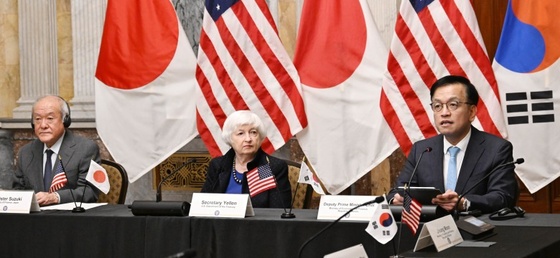[경제노트] (영어로 배우는 국제경제) 'New Economy'
It"s a new world out there, and the old economic models don"t seem to
work anymore.
Nowhere is the change more apparent than at the Federal Reserve.
After years of debate, Fed Chairman Alan Greenspan has convinced his
fellow governors that fundamental changes in the economy especially
the shift toward low inflation require change in monetary policy.
Gone will be the old, secretive Fed, which held that the economy is
inherently unstable and requires preemptive action to avoid trouble
(especially inflation).
In its stead is a new, more transparent central bank that works by
telegraphing its concerns and intentions to the markets.
By simply making known its bias toward easing or tightening, the Fed
will rely on stock and bond markets to do their own economic fine
tuning.
But when the financial system is really threatened, as it was last fall
when Russia defaulted, the Fed will still come in with direct decisive
action.
The Greenspan approach is good news for these changing times.
Old economic models tell us that the economy should be slowing this
late in the business cycle.
Instead, domestic demand is rising.
Inflation should be surging.
It is falling.
Productivity should be plummeting.
Yet it, too, is rising.
Key concepts, such as NAIRU, the nonaccelerating inflation rate of
unemployment, and the Phillips Curve, have lost their ability to explain
and predict.
To his credit, Greenspan recognized early that there is a new economy
even if he could not define all of its contours.
Conservatives on the Fed still wanted to rein it in.
Greenspan was willing to test its limits.
When traditional forecasts predicted higher inflation, he held off
those who wanted to raise interest rates, betting that productivity and
globalization would hold prices in check.
They did.
His opponents are becoming converts.
Now, the Fed will be less inclined to intervene preemptively, more
open about its opinions, and more likely to give growth the benefit of
the doubt.
This is a policy shift of historic dimensions.
= BusinessWeek 5월3일자 사설
-----------------------------------------------------------------------
< 요약 >
미국 중앙은행인 연방준비제도이사회(FRB)가 마침내 고성장과 저물가의
공존이라는 신경제를 인정, 기존의 통화 금융정책 기조에 대해 일대 수정을
가하기로 했다.
경기의 불안한 변동, 특히 인플레에 대한 사전 예방적인 조치를 구실로
깜짝쇼에 가까운 비밀주의적 금융정책을 취해 온 연준리가 보다 공개적이고
예측 가능한 정책으로 선회키로 한 것이다.
역사적인 정책 전환이다.
이는 일찍부터 신경제 현상을 간파했던 앨런 그린스펀 FRB 의장이 보수적
견해를 버리지 않고 있던 다수의 FRB이사들을 끈질기게 설득한 결과이다.
그린스펀 의장은 낡은 경제 모델로는 최근 미국 경제에 나타나고 있는
현상들을 제대로 담아낼 수 없음을 누차 역설해 왔다.
예를 들어 경기에는 호.불황 사이클이 교차하게 마련이라는 구 이론대로
라면 미국 경제는 지금쯤 경기가 둔화되고, 물가는 치솟고, 생산성은
곤두박질치고 있어야 한다.
그러나 실상은 내수가 늘어나고 물가는 떨어지고 생산성은 계속 높아지고
있다.
인플레를 유발하지 않는 저실업률(NAIRU)나 필립스곡선 등의 핵심적인
경제학 개념들은 더 이상 경제 현상을 설명하거나 예측케 할 만한 능력을
잃어버린 상태다.
-----------------------------------------------------------------------
< 용어 설명 >
<> 필립스 곡선
임금 상승률과 실업률은 반비례 관계에 있음을 보여주는 곡선.
실업률이 하락(일손 부족)하면 임금 상승률이 높아지고, 반대로 실업률이
상승하면 임금 상승률이 낮아지는 현상을 설명한 것으로 영국 경제학자인
필립스가 1862년과 1957년 영국의 경험을 분석 대상으로 해서 도출해냈다.
< 뉴욕=이학영 특파원 hyrhee@earthlink.net >
( 한 국 경 제 신 문 1999년 4월 30일자 ).
-
기사 스크랩
-
공유
-
프린트
![[한경에세이] 비상이다. 비상!](https://img.hankyung.com/photo/202404/07.35991182.3.jpg)
![[허원순 칼럼] 22대 국회 '역대 최대' 법률가들의 4가지 책무](https://img.hankyung.com/photo/202404/07.30347388.3.jpg)
![[차장 칼럼] 실장·수석보다 힘 센 용산 비서관](https://img.hankyung.com/photo/202404/07.15766853.3.jpg)











